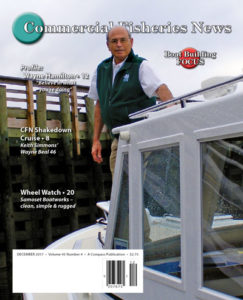For some, the end of the year is a time to remember those we have lost. For others, this is a time to reflect on what the lives of lost family and friends meant to us, and what they contributed to family and community.
In this season of short days, many of us will be engaged in this kind of reflection – with respect to people we knew – as well as to those from near and far away whom we didn’t know, but who nonetheless are sorely missed.

 On the East Coast we may have been spared the big, epic storms of recent years for the most part, but we have not been spared the loss of life in the fishing industry relative to other US coasts.
On the East Coast we may have been spared the big, epic storms of recent years for the most part, but we have not been spared the loss of life in the fishing industry relative to other US coasts.
According to a report issued in July 2017 by the Centers for Disease Control/National Institute for Occupational Safety and Health (CDC/NIOSH), during the period 2010 -2014 the East Coast experienced 60 deaths in the fisheries compared to 45 off Alaska, 40 in the Gulf of Mexico, and 30 on the West Coast.
The number one cause of these fatalities on all coasts was vessel disasters; and the second cause, falls overboard; except on the East Coast where falls overboard tied for first place with vessel disasters.
As Table 1 shows, between 64% and 78% of fishing fatalities, as reported by the CDC/NIOSH for 2010-2014, were caused by vessel disasters and falls overboard.
Table 2 shows a breakdown of all causes of fatalities for six East Coast fisheries with at least four deaths from 2010-2014.
The East Coast lobster fishery experienced a total of 10 fatalities and the second highest fishery was in the scallop fishery with 6 fatalities.
Whereas the lobster fishery tied with two other fisheries for vessel disasters that resulted in fatalities (3 each), the lobster fishery led the other fisheries in fatal falls overboard with 5.
For these CDC/NIOSH reports, vessel disasters are defined as “sinkings, capsizes, groundings, fires, or other events that force crews to abandon ship.”
For the East Coast, the 22 fatalities were the result of 18 vessel disasters.
These disasters resulted from being struck by a large wave (5), flooding (3), unknown events (3), instability (2), prop entanglement (2), and collision/allision, gear caught on bottom, or crossing a hazardous bar (1 each).
We can now reflect on how the risk to life might have been reduced in the vessel disaster category.
All of these vessel disaster events, we can guess, happened suddenly, without warning.
CFN’s SAFE BOAT and FISH SAFE columnists both agree that preparation for these sudden events calls for:
• Vessel integrity;
• Weather watch and boat handling skills;
• Training and regular drills; and
• The functional availability and proper use of equipment such as immersion suits, EPIRBs, VHFs, and liferafts.
See FISH SAFE, CFN Oct. 2017, titled “Could it be? A possible annual self-certification plan” for suggestions as how to do your own risk assessment or analysis of preparedness.
On the topic of reducing the risk to life from falls overboard, we inevitably come back to the life jacket or PFD.
Analysis of drowning data repeatedly points to the lack of a PFD as the reason a fall overboard became a fatal fall.
The life jacket is a critical assist to the 1-10-1 rule of cold water immersion.
In the first minute after a fall into cold water, the body is shocked by the cold. Breathing is difficult – gasping is likely.
A life jacket keeps one afloat with head above water and allows the victim to use the precious first minute to get control of his/her breathing.
The “10” stands for the 10 minutes during which the body becomes increasingly incapacitated – fingers become unable to hold on to things, legs and arms become unable to move effectively, and one ceases to have enough strength to maneuver to a safer place.
The last “1” represents the hour, approximately, until a person experiences hypothermia and becomes unconscious.
A life jacket can increase the potential for surviving long enough for rescue by 60 minutes or more.
In these shortened days, we can take time to reflect on those we have lost in the past year, and reflect on the life we might save in the next year by preparing to FISH SAFE.
Ann Backus, MS, is the director of outreach for the Harvard School of Public Health’s Department of Environmental Health in Boston, MA. She may be reached by phone at
(617) 432-3327 or by e-mail at <abackus@hsph.harvard.edu>.
To get access to the rest of this story and more you’ll need to purchase the
DECEMBER 2017 issue of Commercial Fisheries News.
Please choose from the following options:
• BUY a Single PRINT edition of CFN that is delivered by MAIL. PRINT EDITION
• Quickly enjoy ONLINE access with our Hi-DEF flip-book. PURCHASE THIS ONLINE EDITION
• Shop the Online ARCHIVE
(Read online flip-book immediately with purchased access key and download a copy for yourself to keep.
Not sure if it works for you? Try a FREE SAMPLE HERE.)
• SAVE BIG when you SUBSCRIBE!







